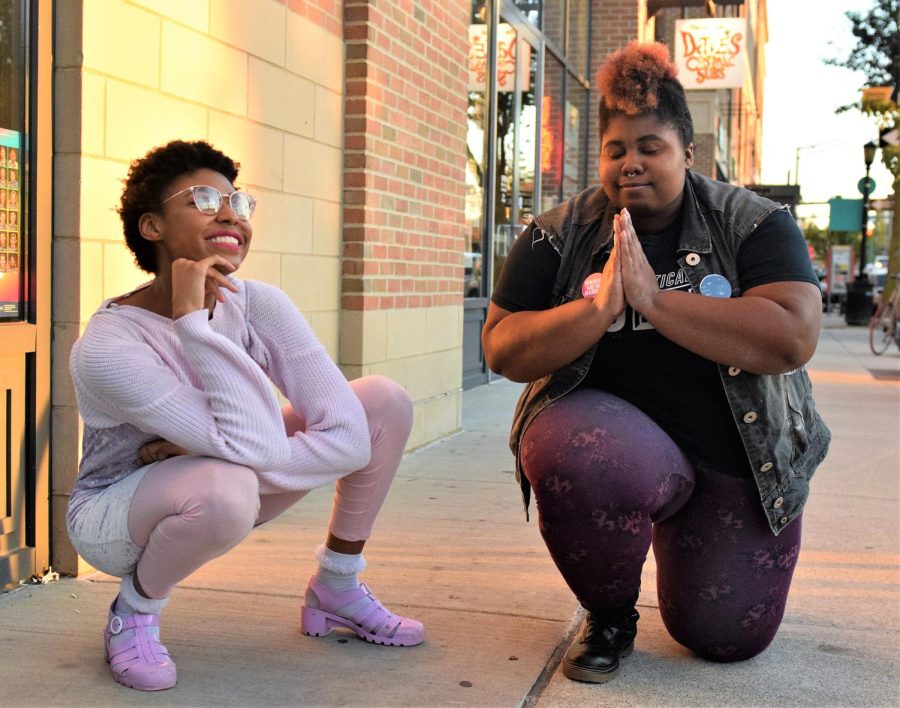Gender-neutral clothing becomes new trend
Rue Monroe, a sophomore theatre studies major, and Jordin Manning, a sophomore zoology major, pose for a portrait in downtown Kent Friday, Oct. 20, 2017.
October 20, 2017
When it comes to gender, the fashion industry is increasingly finding itself shying away from the masculine versus feminine structure that has been in place for centuries and instead favoring a gender-neutral style.
The trend has been making headlines since Vogue gave it center stage in its July issue. The cover, featuring model Gigi Hadid and her pop star boyfriend Zayn Malik, said the couple “shop each other’s closets.” The article within declared the pair a “part of a new generation who don’t see fashion as gendered.”
The Vogue cover faced backlash for initially declaring Hadid and Malik as “genderfluid” despite neither of them being genderfluid. Vogue apologized publicly and changed the title of the article, but the content stayed the same.
“But where, exactly, is someone neither entirely he nor she meant to shop?” The article asked. “And how, exactly, is such a person to be defined?”
The only meaningful way to define gender is for individuals to define it for themselves.
While Hadid and Malik talk about this shift in strict gender-specific styles as “not about gender,” for those who are genderfluid or non-binary, it can be as much about gender as it is about self-expression.
“I feel like gender and gender expression is fluid,” said Rue Monroe, a sophomore theatre studies major who is non-binary. “People have been living outside the binary with fashion for years.”
Suzanne Holt, an assistant professor of women’s studies, said these “gender-absolute trends” have been in place since the turn of the millennium and have become some of our most insistent fashion trends.
“That really created an either-or scenario for girls and boys – and men and women, to a degree – that felt almost pathological at times,” Holt said. “There was a kind of insecurity with anything that wasn’t absolutely locked down. It went across not just fashion but obviously beauty products. Everything had to be marked male or female.”
In September, The New York Times reported John Lewis, a British department store chain, decided to stop separating their children’s clothing into genders, instead labelling clothes as “boys & girls.”
“(We) want to provide greater choice and variety to our customers, so that the parent or child can choose what they would like to wear,” Caroline Bettis, the brand’s head of children’s wear, told the Times.
For Jordin Manning, a sophomore zoology student who is non-binary, class, size and ability will still be a factor in the availability of gender-neutral clothes. Manning said they continue to see models who are thin, white and able-bodied.
“With these new trends coming up, a lot more companies are going to want to price it at the highest (level) because it’s a trend and they want to make the most money out of it,” Manning said. “I think, out of that can come a positive, with the demand for gender-neutral clothing for all sizes and for all abilities.”
Holt said society is beginning to look at “outcomes of our gender extremes” and decided they aren’t healthy for boys or girls, leading to pushback against retailers labelling things from clothing to toys by gender.
“Capitalism is amoral,” Holt said. “It follows ‘is there enough of an audience? Is there money to be lost if we don’t? Is there money to be gained if we do?’ So you definitely have that real politic of business that’s playing.”
Monroe believes the trend could also be an eye-opener for people who aren’t familiar with non-binary or genderfluid people.
“I feel like it would kind of show people, ‘Oh, people have been doing this for years,’” Monroe said. “Gender expression doesn’t equal sexuality. It’s a good way to kind of get people’s foot in the door of being more aware of this culture.”
Holt describes the trend as a healthy response to a status quo that firmly pits masculine and feminine as opposites, without much definition to the words otherwise. She said that we expect to know who someone is, one way or the other, from the moment of birth.
“Gender-neutral clothing is an act of overt rebellion against this ‘declare yourself,’” Holt said. “In a way, it’s like saying ‘I’m human. That’s all you need to know.’”
Ella Abbott is the fashion reporter. Contact her at [email protected].

























